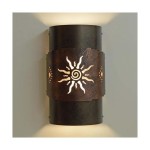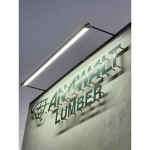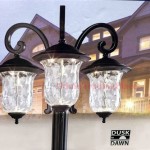Adding a Motion Sensor to an Outdoor Light: A Comprehensive Guide
Improving home security and energy efficiency are common goals for homeowners. A simple and effective way to achieve both is by adding a motion sensor to an existing outdoor light. This enhancement allows the light to activate only when movement is detected, providing illumination when needed for security purposes and conserving energy during inactive periods. This article provides a comprehensive guide to understanding the process, benefits, and considerations associated with adding a motion sensor to an outdoor light.
Understanding the Benefits of Motion-Activated Outdoor Lighting
Motion-activated outdoor lighting offers several advantages. Firstly, it significantly enhances home security. The sudden illumination can deter potential intruders by creating the impression that someone is alerted to their presence. Burglars often avoid well-lit areas, making motion-activated lights a valuable deterrent.
Secondly, motion sensors contribute to energy conservation. Traditional outdoor lights often remain illuminated throughout the night, consuming considerable electricity. Motion sensors allow the light to stay off until movement is detected, reducing energy consumption and lowering electricity bills. This feature is particularly beneficial for homeowners concerned about their environmental footprint and reducing their operational costs.
Thirdly, motion-activated lights provide convenience. They automatically illuminate pathways and entrances upon approach, eliminating the need to fumble for keys or navigate in the dark. This is especially useful when carrying groceries or packages, offering a safer and more convenient experience for residents and guests.
Types of Motion Sensors for Outdoor Lights
Several types of motion sensors are available for outdoor lighting, each with its own advantages and disadvantages. Understanding the different types is crucial for choosing the right sensor for a specific application.
Passive Infrared (PIR) sensors are the most common type. These sensors detect changes in infrared radiation emitted by moving objects. They are relatively inexpensive and reliable, making them a popular choice for residential use. PIR sensors are sensitive to temperature variations, which can sometimes lead to false triggers, such as when a hot car passes by or the sun heats up a nearby surface.
Microwave sensors, also known as radar sensors, emit microwave radiation and detect changes in the reflected signal. These sensors are more sensitive than PIR sensors and can detect movement through walls and other obstructions. However, they are also more prone to false triggers from moving trees or other environmental factors. Microwave sensors typically have a longer range than PIR sensors, making them suitable for larger areas.
Dual-technology sensors combine PIR and microwave technology. This combination helps to minimize false triggers by requiring both sensors to detect movement before activating the light. Dual-technology sensors are more expensive than single-technology sensors but offer increased reliability and accuracy.
Ultrasonic sensors emit ultrasonic sound waves and detect changes in the reflected signal. They are less common for outdoor lighting applications due to their limited range and susceptibility to interference from environmental noise. However, they can be useful in specific situations where other sensor types are not suitable.
Installation Process: A Step-by-Step Guide
Adding a motion sensor to an outdoor light typically involves replacing the existing light fixture with one that features an integrated motion sensor or adding a separate motion sensor unit. The installation process generally requires basic electrical knowledge and adherence to safety precautions.
The first step is to disconnect the power supply to the outdoor light at the circuit breaker. This is a critical safety measure to prevent electrical shock. Double-check that the power is off before proceeding with any wiring work. It is recommended to use a non-contact voltage tester to confirm that the wires are de-energized.
Next, carefully remove the existing light fixture. This usually involves unscrewing the fixture from the junction box. After removing the fixture, carefully disconnect the wires. Typically, there will be a black (hot) wire, a white (neutral) wire, and a green or bare copper (ground) wire. Use wire strippers to expose fresh wire ends if necessary.
If installing a separate motion sensor unit, mount the sensor according to the manufacturer's instructions. The sensor should be positioned in a location that provides optimal coverage of the desired area. Avoid pointing the sensor towards heat sources or areas with significant movement that could cause false triggers. The height of the sensor is also a critical factor, as too high or too low can affect its range and accuracy.
Connect the wires of the new light fixture or motion sensor to the corresponding wires in the junction box. Use wire connectors (wire nuts) to securely connect the wires. Ensure that the connections are tight and secure to prevent loose wires, which can cause electrical problems.
Once the wiring is complete, carefully tuck the wires back into the junction box and attach the new light fixture or motion sensor unit. Ensure that the fixture is securely mounted to the junction box. If necessary, use sealant to weatherproof the fixture and prevent moisture from entering the junction box.
Finally, restore power to the circuit breaker and test the new motion-activated light. Walk within the sensor's range to trigger the light. Adjust the sensitivity and duration settings on the motion sensor as needed. Most motion sensors have adjustable settings for sensitivity (the distance at which motion is detected) and duration (the length of time the light stays on after motion is detected).
Factors to Consider When Choosing a Motion Sensor
Several factors should be considered when selecting a motion sensor for an outdoor light. The specific needs and environment of the property will influence the ideal choice.
The first consideration is the range and coverage area. Determine the area that needs to be illuminated and choose a sensor with an appropriate range. Consider the mounting height and angle of the sensor to ensure optimal coverage. A sensor with a wide detection angle will cover a larger area, while a sensor with a narrow angle may be more suitable for focused areas like doorways or pathways.
Sensitivity settings are another important consideration. Adjust the sensitivity settings to minimize false triggers. Consider the surrounding environment and adjust the sensitivity accordingly. In areas with frequent small animal activity or windy conditions, a lower sensitivity setting may be necessary.
Durability and weather resistance are crucial for outdoor applications. Choose a sensor that is designed to withstand outdoor conditions, including rain, snow, and extreme temperatures. Look for sensors with a weatherproof rating of IP65 or higher. This rating indicates that the sensor is protected against dust and water ingress.
Power source is a further aspect to evaluate. Motion sensors can be powered by standard electrical wiring, batteries, or solar energy. Wired sensors are the most reliable but require access to electrical wiring. Battery-powered sensors are easy to install but require periodic battery replacement. Solar-powered sensors are energy-efficient but may not function reliably in areas with limited sunlight.
Finally, the style and aesthetics of the sensor should be considered. Choose a sensor that complements the existing outdoor lighting fixtures and the overall style of the property. Motion sensors are available in a variety of styles and finishes to match different architectural designs.
Troubleshooting Common Issues
Even with careful installation, issues may arise with motion-activated outdoor lights. Understanding common problems and their solutions can save time and frustration.
One common issue is the light turning on and off repeatedly without any apparent cause. This is often due to false triggers caused by sensitivity settings that are too high, or by movement from trees, bushes, or animals. Adjusting the sensitivity settings or trimming nearby vegetation can often resolve this issue.
Another issue is the light not turning on at all when motion is detected. This could be due to a faulty sensor, a loose wire connection, or a blown light bulb. Check the light bulb first and replace it if necessary. Then, inspect the wiring connections to ensure they are secure. If the problem persists, the sensor may be faulty and need to be replaced.
Sometimes, the light will stay on constantly, even when there is no motion. This could be due to a stuck sensor, a wiring problem, or a misconfigured setting. Try resetting the sensor by turning off the power to the circuit breaker for a few minutes and then turning it back on. If the problem persists, consult the manufacturer's instructions or contact an electrician.
False triggers caused by temperature changes can also be a problem with PIR sensors. Positioning the sensor away from direct sunlight or heat sources can help to minimize these triggers. Additionally, upgrading to a dual-technology sensor, which combines PIR and microwave technology, can reduce false triggers significantly.
Finally, ensure that the sensor is clean and free from obstructions. Dust, dirt, and spider webs can interfere with the sensor's ability to detect motion. Periodically clean the sensor lens with a soft cloth to ensure optimal performance.
By considering these factors and following the installation guidelines, homeowners can effectively add a motion sensor to their outdoor lights, enhancing security, conserving energy, and improving convenience.

Can You Add Motion Sensors To Existing Outdoor Lights Led Lighting Info

Can You Add Motion Sensors To Existing Outdoor Lights Led Lighting Info

How To Add A Light Sensor Outdoor Lanterns The Navage Patch

Can You Add Motion Sensors To Existing Outdoor Lights Led Lighting Info

Can You Add Motion Sensors To Existing Outdoor Lights Local Electrical Group

Can You Add Motion Sensors To Existing Outdoor Lights Local Electrical Group

How To Add Motion Sensor Outdoor Lights With Or Function Doityourself Com Community Forums
Is It Possible To Add A Single Motion Sensor Set Of Outdoor Floodlights That Are Controlled By Two 3 Way Switches Quora

Can You Add Motion Sensors To Existing Outdoor Lights Local Electrical Group

How To Wire Motion Sensor Occupancy Sensors







